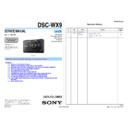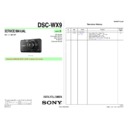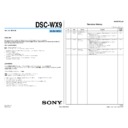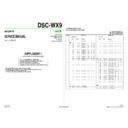Read Sony DSC-WX9 (serv.man2) Service Manual online
DSC-WX9_L2
Sony Corporation
SERVICE MANUAL
Revision History
SERVICE NOTE (Check the following note before the service.)
LEVEL
2
Published by Sony Techno Create Corporation
983455732.pdf
Ver. 1.1 2011.07
DIGITAL STILL CAMERA
The components identified by
mark
mark
0 or dotted line with mark
0 are critical for safety.
Replace only with part number
specified.
Replace only with part number
specified.
Les composants identifiés par
une marque
une marque
0 sont critiques pour
la sécurité.
Ne les remplacer que par une piè-
ce portant le numéro spécifié.
Ne les remplacer que par une piè-
ce portant le numéro spécifié.
US Model
Canadian Model
AEP Model
E Model
Chinese Model
Photo: Black
9-834-557-32
DSC-WX9
Ver.
Date
History
Contents
S.M. Rev.
issued
1.0
2010.12
Official Release
—
—
1.1
2011.07
Revised-1
(A1 11-045)
• Revision of SERVICE NOTE.
Page
Page
1-3
• Revision of EXPLODED VIEWS.
Page
Page
2-6
Yes
2011G08-1
© 2011.07
– ENGLISH –
1-1. Notes on Using Tripod Adapter
1-2. PRECAUTION ON REPLACING THE SY-281 BOARD
1-3. METHOD FOR COPYING OR ERASING THE DATA IN INTERNAL MEMORY
1-4. HOW TO WRITE DATA TO INTERNAL MEMORY
1-5. SELF-DIAGNOSIS
1-2. PRECAUTION ON REPLACING THE SY-281 BOARD
1-3. METHOD FOR COPYING OR ERASING THE DATA IN INTERNAL MEMORY
1-4. HOW TO WRITE DATA TO INTERNAL MEMORY
1-5. SELF-DIAGNOSIS
FUNCTION
1-6. PROCESS AFTER FIXING FLASH ERROR
1-7. ORNAMENTAL RING A OR BARRIER ASSY REPLACING METHOD
1-8. OPTICALSTEPPING MOTOR (F1430) REPLACING METHOD
1-9. DC MOTOR WORM (A) BLOCK ASSY REPLACING METHOD
1-10. TWO TUBE LIBRICATING BLOCK ASSY AND GROUP 1 FRAME REPLACING
1-7. ORNAMENTAL RING A OR BARRIER ASSY REPLACING METHOD
1-8. OPTICALSTEPPING MOTOR (F1430) REPLACING METHOD
1-9. DC MOTOR WORM (A) BLOCK ASSY REPLACING METHOD
1-10. TWO TUBE LIBRICATING BLOCK ASSY AND GROUP 1 FRAME REPLACING
METHOD
1-11. FINAL INSPECTION
Internal memory
ON BOARD
Internal memory
ON BOARD
Revised-1
Replace the previously issued
SERVICE MANUAL 9-834-557-31
with this Manual.
SERVICE MANUAL 9-834-557-31
with this Manual.
DSC-WX9_L2
– 2 –
SPECIFICATIONS
Camera
[System]
Image device: 7.77 mm (1/2.3 type)
Exmor R CMOS sensor
Total pixel number of camera:
Approx. 16.8 Megapixels
Effective pixel number of camera:
Approx. 16.2 Megapixels
Lens: Carl Zeiss Vario-Tessar 5× zoom lens
f = 4.5 mm – 22.5 mm (25 mm –125 mm
(35 mm film equivalent))
F2.6 (W) – F6.3 (T)
While shooting movies (16:9):
29 mm – 145 mm
While shooting movies (4:3):
35 mm – 175 mm
(35 mm film equivalent))
F2.6 (W) – F6.3 (T)
While shooting movies (16:9):
29 mm – 145 mm
While shooting movies (4:3):
35 mm – 175 mm
SteadyShot: Optical
Exposure control: Automatic exposure,
Exposure control: Automatic exposure,
Scene Selection (14 modes)
White balance: Automatic, Daylight,
Cloudy, Fluorescent 1/2/3,
Incandescent, Flash, One Push
Incandescent, Flash, One Push
Signal format:
For 1080 50i: PAL color, CCIR
standards HDTV 1080/50i
specification
For 1080 60i: NTSC color, EIA
standards HDTV 1080/60i
specification
standards HDTV 1080/50i
specification
For 1080 60i: NTSC color, EIA
standards HDTV 1080/60i
specification
File format:
Still images: JPEG (DCF Ver. 2.0,
Exif Ver. 2.3, MPF Baseline)
compliant, DPOF compatible
3D still images: MPO (MPF Extended
(Disparity Image)) compliant
Movies (AVCHD format):
AVCHD
Video: MPEG-4 AVC/H.264
Audio: Dolby Digital 2ch,
equipped with Dolby Digital Stereo Creator
• Manufactured under license from
Exif Ver. 2.3, MPF Baseline)
compliant, DPOF compatible
3D still images: MPO (MPF Extended
(Disparity Image)) compliant
Movies (AVCHD format):
AVCHD
Video: MPEG-4 AVC/H.264
Audio: Dolby Digital 2ch,
equipped with Dolby Digital Stereo Creator
• Manufactured under license from
Dolby Laboratories.
Movies (MP4 format):
Video: MPEG-4 AVC/H.264
Audio: MPEG-4 AAC-LC 2ch
Audio: MPEG-4 AAC-LC 2ch
Recording media: Internal Memory
(Approx. 19 MB), “Memory Stick
Duo” media, SD cards
Duo” media, SD cards
Flash: Flash range (ISO sensitivity
(Recommended Exposure Index) set to Auto):
Approx. 0.05 m to 5.3 m
(2 inches to 17 feet 4 3/4 inches) (W)
Approx. 1.0 m to 2.2 m
(3 feet 3 3/8 inches to 7 feet 2 5/8 inches) (T)
Approx. 0.05 m to 5.3 m
(2 inches to 17 feet 4 3/4 inches) (W)
Approx. 1.0 m to 2.2 m
(3 feet 3 3/8 inches to 7 feet 2 5/8 inches) (T)
[Input and Output connectors]
HDMI connector: HDMI mini jack
Multi connector: Type3b
Multi connector: Type3b
(AV-out/USB/DC-in):
Video output
Audio output (Stereo)
USB communication
Video output
Audio output (Stereo)
USB communication
USB communication: Hi-Speed USB
(USB 2.0)
[LCD screen]
LCD panel:
7.5 cm (3.0 type) TFT drive
Total number of dots:
921 600 (640 × 3 (RGB) × 480) dots
[Power, general]
Power: Rechargeable battery pack
NP-BN1, 3.6 V
AC Adaptor AC-UB10/UB10B,
5 V
AC Adaptor AC-UB10/UB10B,
5 V
Power consumption (during shooting):
1.1 W
Operating temperature:
0 °C to 40 °C (32 °F to 104 °F)
Storage temperature:
–20 °C to +60 °C (–4 °F to +140 °F)
Dimensions (CIPA compliant):
94.6 mm × 56.3 mm × 19.8 mm
(3 3/4 inches × 2 1/4 inches × 25/32 inches)
(W/H/D)
(3 3/4 inches × 2 1/4 inches × 25/32 inches)
(W/H/D)
Mass (CIPA compliant) (including NP-
BN1 battery pack, “Memory Stick
Duo” media):
Approx. 139 g (4.3 oz)
Duo” media):
Approx. 139 g (4.3 oz)
Microphone: Stereo
Speaker: Monaural
Exif Print: Compatible
PRINT Image Matching III:
Speaker: Monaural
Exif Print: Compatible
PRINT Image Matching III:
Compatible
AC Adaptor AC-UB10/UB10B
Power requirements: AC 100 V to
240 V, 50 Hz/60 Hz, 70 mA
Output voltage: DC 5 V, 0.5 A
Operating temperature:
Operating temperature:
0 °C to 40 °C (32 °F to 104 °F)
Storage temperature:
–20 °C to +60 °C (–4 °F to +140 °F)
Dimensions:
Approx. 50 mm × 22 mm × 54 mm
(2 inches × 7/8 inches × 2 1/4 inches)
(W/H/D)
(2 inches × 7/8 inches × 2 1/4 inches)
(W/H/D)
Mass:
For the USA and Canada:
Approx. 48 g (1.7 oz)
For countries or regions other than
the USA and Canada:
Approx. 43 g (1.5 oz)
Approx. 48 g (1.7 oz)
For countries or regions other than
the USA and Canada:
Approx. 43 g (1.5 oz)
Rechargeable battery pack
NP-BN1
NP-BN1
Used battery: Lithium-ion battery
Maximum voltage: DC 4.2 V
Nominal voltage: DC 3.6 V
Maximum charge voltage: DC 4.2 V
Maximum charge current: 0.9 A
Capacity:
Maximum voltage: DC 4.2 V
Nominal voltage: DC 3.6 V
Maximum charge voltage: DC 4.2 V
Maximum charge current: 0.9 A
Capacity:
typical: 2.3 Wh (630 mAh)
minimum: 2.2 Wh (600 mAh)
minimum: 2.2 Wh (600 mAh)
Design and specifications are subject to
change without notice.
change without notice.
SAFETY-RELATED COMPONENT WARNING!!
COMPONENTS IDENTIFIED BY MARK 0 OR DOTTED LINE WITH
MARK 0 ON THE SCHEMATIC DIAGRAMS AND IN THE PARTS LIST
ARE CRITICAL TO SAFE OPERATION. REPLACE THESE COMPO-
NENTS WITH SONY PARTS WHOSE PART NUMBERS APPEAR AS
SHOWN IN THIS MANUAL OR IN SUPPLEMENTS PUBLISHED BY
SONY.
MARK 0 ON THE SCHEMATIC DIAGRAMS AND IN THE PARTS LIST
ARE CRITICAL TO SAFE OPERATION. REPLACE THESE COMPO-
NENTS WITH SONY PARTS WHOSE PART NUMBERS APPEAR AS
SHOWN IN THIS MANUAL OR IN SUPPLEMENTS PUBLISHED BY
SONY.
ATTENTION AU COMPOSANT AYANT RAPPORT
À LA SÉCURITÉ!
LES COMPOSANTS IDENTIFIÉS PAR UNE MARQUE 0 SUR LES
DIAGRAMMES SCHÉMATIQUES ET LA LISTE DES PIÈCES SONT
CRITIQUES POUR LA SÉCURITÉ DE FONCTIONNEMENT. NE REM-
PLACER CES COMPOSANTS QUE PAR DES PIÈCES SONY DONT
LES NUMÉROS SONT DONNÉS DANS CE MANUEL OU DANS LES
SUPPLÉMENTS PUBLIÉS PAR SONY.
DIAGRAMMES SCHÉMATIQUES ET LA LISTE DES PIÈCES SONT
CRITIQUES POUR LA SÉCURITÉ DE FONCTIONNEMENT. NE REM-
PLACER CES COMPOSANTS QUE PAR DES PIÈCES SONY DONT
LES NUMÉROS SONT DONNÉS DANS CE MANUEL OU DANS LES
SUPPLÉMENTS PUBLIÉS PAR SONY.
Caution
Danger of explosion if battery is incorrectly replaced.
Replace only with the same or equivalent type.
Dispose of used batteries according to the instructions.
Replace only with the same or equivalent type.
Dispose of used batteries according to the instructions.
UNLEADED SOLDER
This unit uses unleaded solder.
Boards requiring use of unleaded solder are printed with the lead free
mark (LF) indicating the solder contains no lead.
(Caution: Some printed circuit boards may not come printed with the
Boards requiring use of unleaded solder are printed with the lead free
mark (LF) indicating the solder contains no lead.
(Caution: Some printed circuit boards may not come printed with the
lead free mark due to their particular size.)
: LEAD FREE MARK
Be careful to the following points to solder or unsolder.
• Set the soldering iron tip temperature to 350 °C approximately.
If cannot control temperature, solder/unsolder at high temperature
for a short time.
Caution: The printed pattern (copper foil) may peel away if the
for a short time.
Caution: The printed pattern (copper foil) may peel away if the
heated tip is applied for too long, so be careful!
Unleaded solder is more viscous (sticky, less prone to
flow) than ordinary solder so use caution not to let solder
bridges occur such as on IC pins, etc.
flow) than ordinary solder so use caution not to let solder
bridges occur such as on IC pins, etc.
• Be sure to control soldering iron tips used for unleaded solder and
those for leaded solder so they are managed separately. Mixing un-
leaded solder and leaded solder will cause detachment phenomenon.
leaded solder and leaded solder will cause detachment phenomenon.
SAFETY CHECK-OUT
After correcting the original service problem, perform the following
safety checks before releasing the set to the customer.
1. Check the area of your repair for unsoldered or poorly-soldered
connections. Check the entire board surface for solder splashes and
bridges.
bridges.
2. Check the interboard wiring to ensure that no wires are “pinched”
or contact high-wattage resistors.
3. Look for unauthorized replacement parts, particularly transistors,
that were installed during a previous repair. Point them out to the
customer and recommend their replacement.
customer and recommend their replacement.
4. Look for parts which, through functioning, show obvious signs of
deterioration. Point them out to the customer and recommend their
replacement.
replacement.
5. Check the B+ voltage to see it is at the values specified.
6. Flexible Circuit Board Repairing
6. Flexible Circuit Board Repairing
• Set the soldering iron tip temperature to 350 °C approximately.
• Do not touch the soldering iron on the same conductor of the circuit
board (within 3 times).
• Be careful not to apply force on the conductor when soldering or
unsoldering.
Model information table
Model
DSC-WX9
Destination
US
CND
CH
E
Color system
NTSC
NTSC
PAL
PAL
TransferJet
• Abbreviation
CH : Chinese model
CND : Canadian model
CH : Chinese model
CND : Canadian model
DSC-WX9_L2
1-1
1. SERVICE NOTE
1-1. Notes on Using Tripod Adaptor
This model uses a Tripod Adaptor for adjustments.
When using a Tripod Adaptor, alter the USB, A/V cable for multi-use terminal as shown in the figure below.
When using a Tripod Adaptor, alter the USB, A/V cable for multi-use terminal as shown in the figure below.
1-2. PRECAUTION ON REPLACING THE SY-281 BOARD
DESTINATION DATA
When you replace to the repairing board, the written destination data of repairing board also might be changed to original setting.
Start the Adjust Manual in the Adjust Station and execute the “DESTINATION DATA WRITE”.
Start the Adjust Manual in the Adjust Station and execute the “DESTINATION DATA WRITE”.
RESTORE DATA
When you replace to the repairing board, get the data from the former one.
Start the Adjust Manual in the Adjust Station and perform “RESTORE DATA” to get the data.
The data getting for this model is as follows.
Start the Adjust Manual in the Adjust Station and perform “RESTORE DATA” to get the data.
The data getting for this model is as follows.
• USB SERIAL No.
• Angular Velocity Sensor Sensitivity adjustment
• AWB standard data input & check, Color reproduction check
• Angular Velocity Sensor Sensitivity adjustment
• AWB standard data input & check, Color reproduction check
Note: When you cannot read data from the former replace the same time SY-281 board and lens.
Regarding the PMB Portable
PMB Portable has been written in internal memory.
SY-281 board for service is supplied with written the PMB Portable.
SY-281 board for service is supplied with written the PMB Portable.
USB SERIAL No.
The set is shipped with a unique ID (USB Serial No.) written in it.
This ID has not been written in a new board for service, and therefore it must be entered after the board replacement.
Start the Adjust Manual in the Adjust Station and execute the “USB SERIAL No. INPUT”.
This ID has not been written in a new board for service, and therefore it must be entered after the board replacement.
Start the Adjust Manual in the Adjust Station and execute the “USB SERIAL No. INPUT”.
Angular Velocity Sensor
When you replace to the repairing board, write down the sensitivity displayed on the angular velocity sensor (SE401).
Start the Adjust Manual in the Adjust Station and execute the “Angular velocity sensor sensitivity adj”.
Start the Adjust Manual in the Adjust Station and execute the “Angular velocity sensor sensitivity adj”.
SY-281 BOARD (SIDE A)
SE401
PP
YY
YY
PP: PITCH sensor sensitivity
YY: YAW sensor sensitivity
YY: YAW sensor sensitivity
Note: The sensor sensitivity of SE401 of SY-281 board is written only repair parts.
– ENGLISH –
1-3. METHOD FOR COPYING OR ERASING THE DATA IN INTERNAL MEMORY
The data can be copied/erased by the operations on the HOME screen. (When erasing the data, execute formatting the internal memory.)
Note 1:When replacing the SY-281 board, erase the data in internal memory of the board before replacement.
Note 2:When replacing the SY-281 board, execute formatting and initialize the internal memory after replacement.
Note 2:When replacing the SY-281 board, execute formatting and initialize the internal memory after replacement.
Method for Copying the Data in Internal Memory
Copy
Copies all images in the internal memory to a memory card.
1. Insert a memory card with sufficient free capacity into the camera.
2. MENU
(Settings)
(Memory Card Tool)
[Copy]
[OK]
Notes
Use a fully charged battery pack. If you attempt to copy image files using a battery pack with little
remaining charge, the battery pack may run out, causing copying to fail or possibly corrupting the
data.
Images cannot be copied individually.
The original images in the internal memory are retained even after copying. To delete the
contents of the internal memory, remove the memory card after copying, then format the internal
memory ([Format] in [Internal Memory Tool]).
The data will be copied to the recording folder that is currently being used, with a number one
higher than the largest data number in that folder.
[Details]
Method for Formatting the Internal Memory or “Memory Stick Duo” media
Format
Formats the memory card or the internal memory.
When you use a memory card with this camera for the first time, it is recommended to format the card
using the camera for stable performance of the memory card before shooting. Note that formatting
permanently erases all data on the memory card, and is unrecoverable. Save precious data on a
computer, etc.
1. MENU
(Settings)
(Memory Card Tool) or
(Internal Memory Tool)
[Format]
[OK]
Note
Note that formatting permanently erases all data including even protected images.
DSC-WX9_L2
1-2
– ENGLISH –
1-4. HOW TO WRITE DATA TO INTERNAL MEMORY
Usually, the camera has been set so as to disable the data writing from the PC to the internal memory of the camera.
This setting must be changed temporarily when the data is to be written to the internal memory such as a case after the board replacement.
To change settings is enabled with using the writing enabler tool (Write Enable Tool) on the Adjust Manual is activating from the Adjust Station.
This setting must be changed temporarily when the data is to be written to the internal memory such as a case after the board replacement.
To change settings is enabled with using the writing enabler tool (Write Enable Tool) on the Adjust Manual is activating from the Adjust Station.
Data writing method
1) Start the Adjust Manual from the Adjust Station.
2) Click
(Write Enable Tool) button.
3) Click “Activate Write Enable Mode” button.
4) Upon completion of the setting change, the following message will be displayed.
5) Return the driver to the original one, and connect the PC to the camera (USB mode: Mass Storage).
6) Write the data read out into the PC to the internal memory of the camera.
7) Disconnect the PC from the camera, and turn off the camera.
6) Write the data read out into the PC to the internal memory of the camera.
7) Disconnect the PC from the camera, and turn off the camera.
Note: By turning off the camera, the write enable setting is reset.
1-5. SELF-DIAGNOSIS FUNCTION
1-5-1. Self-diagnosis Function
When problems occur while the unit is operating, the self-diagnosis func-
tion starts working, and displays on the LCD screen what to do.
Details of the self-diagnosis functions are provided in the Instruction
manual.
tion starts working, and displays on the LCD screen what to do.
Details of the self-diagnosis functions are provided in the Instruction
manual.
1-5-2. Self-diagnosis Display
When problems occur while the unit is operating, the LCD screen shows
a 4-digit display consisting of an alphabet and numbers, which blinks at
3.2 Hz. This 5-character display indicates the “repaired by:”, “block” in
which the problem occurred, and “detailed code” of the problem.
a 4-digit display consisting of an alphabet and numbers, which blinks at
3.2 Hz. This 5-character display indicates the “repaired by:”, “block” in
which the problem occurred, and “detailed code” of the problem.
0 0
3 2
C
Repaired by:
Refer to “1-5-3. Self-diagnosis Code Tabl e”.
Indicates the appropriate
step to be taken.
E.g.
13 ....Format the “memory card”.
32 ....Turn on power again.
13 ....Format the “memory card”.
32 ....Turn on power again.
Block
Detailed Code
Blinks at 3.2 Hz
C : Corrected by customer
E : Corrected by service
engineer
LCD screen
0 0
3 2
C
Repaired by:
Refer to “1-5-3. Self-diagnosis Code Tabl e”.
Indicates the appropriate
step to be taken.
E.g.
13 ....Format the “memory card”.
32 ....Turn on power again.
13 ....Format the “memory card”.
32 ....Turn on power again.
Block
Detailed Code
Blinks at 3.2 Hz
C : Corrected by customer
E : Corrected by service
engineer
LCD screen




